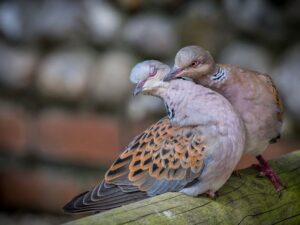By Dr. Beth Leermakers
“On the first day of Christmas, my true love gave to me a partridge in a pear tree.” As the popular Christmas carol continues, five other birds join the list of gifts. To demonstrate love and caring, the gifts include food (the birds) and entertainment (the pipers and dancing ladies). The English carol first appeared in print in 1780.
Instead of focusing on these six birds as tasty main dishes, I’ll share a few interesting facts about them.
Partridge. The red-legged partridge (Alectoris Rufa), found in Western Europe throughout the year, probably inspired the song writer. Also known as the French partridge, this bird was introduced to the UK from Western Europe during the 1700’s as a gamebird. The red-legged partridge is a plump, round gamebird often found on farmland in Europe. In North American, the red-legged partridge may be seen in game reserves or zoos. These birds prefer to run when they’re disturbed, but they will fly short distances. Partridges nest and lay their eggs on the ground, among dense cover — not in pear or any other trees.
Turtle dove. Turtle doves are monogamous and mate for life. The female chooses a mate, and then the couple works together to build a nest. Both parents take turns incubating the eggs, which hatch two to three weeks later. Both male and female doves (and pigeons) produce crop milk (a soft, lumpy high-protein milk) that is used to feed the newborn chicks.

Photo courtesy of the Suzzex Wildlife Trust
European Turtle doves (just called turtle doves) are the only long-distance migratory dove species in Europe. They spend four months in Europe, their breeding ground, and then travel more than 6,800 miles to spend the winter in West Africa. European Turtle Doves are considered a vulnerable species. Their population has declined drastically due to diminished breeding grounds, reduced food availability, illegal poaching and being shot as they migrate across Europe.
French hen. These are chickens from an unspecified French species. The Gauloise Blanche de Bresse chicken is revered in France as a national treasure. The image of the Bresse rooster appears on currency and athletic and military uniforms. Bresse chickens, known for being delicious, can only be raised in a specified geographic area, with their breeding overseen by a single entity, the Comité Interprofesionnel de la Volaille de Bresse (CIVB). One million chicks per year are distributed to approved poultry farms to be raised according to strict standards (access to 10 square meters of pasture per bird). Bresse hens lay up to 250 eggs per year. Three Bresse hens would be a very generous gift when egg prices are so high.
Eurasian blackbird (calling birds). Some song lyrics use an older term — “Colly” birds — instead of “calling” birds (songbirds). “Colly” is an Old English word for black or coal. The Eurasian blackbird (Turdus merula) fits both descriptions. The Eurasian blackbird is socially monogamous for life, but some males may pursue a female that already has a mate. When it comes to attracting a mate, beak color matters. Females prefer orange beaks (that come from more carotenoids in his diet) that suggest the male has better foraging ability and will be a better provider for the chicks. Both the male and female provide food (earthworms) for the hatchlings.
The Eurasian blackbird can change the pitch and volume of its call depending on the environment. The closer the bird is to noisy urban areas, the higher the pitch. This bird also changes the pattern and pitch of its song when it intends to fight.
Graylag goose (Anser anser). Of the 30 species of wild geese in the world, the Graylag goose is probably the one referred to in the song (and common nursery rhymes). The Graylag goose is one of six species of gray geese found in Europe. Wild Graylag geese are rare in North America, but domestic geese (that descended from them) are common in North American parks and farms. Graylag geese are monogamous for life, forming pair bonds when they are three to four years old. The female lays four to six eggs and incubates them for 28 days.
Apart from nesting season (when the couples isolate themselves), these geese live in large flocks with several families. The birds highest in the hierarchy stand guard while other family members forage. If a predator appears, the entire flock “mobs” the interloper. Adults from several families form a protective circle around the goslings while other flockmates attack the predator.
Mute Swan. (Cygnus Olor). Like the other birds in the song (except partridges), mute swans form long-lasting pair bonds.
They usually mate for life, but mate changing occurs occasionally. Swans will remate if their partner dies. If a male loses his mate and pairs up with a young female, she joins him on his territory. If he chooses an older female, they go to her territory. A female who loses her mate chooses a new mate — usually a younger male — quickly. Mute swans defend their breeding territory aggressively. Territorial fights between males sometimes end with the dominant bird pushing his rival under water. These swans also chase off ducks, gulls, geese, dogs and people.
Whatever your true love gives you, I hope you have a wonderful holiday celebration.
Merry Christmas!
